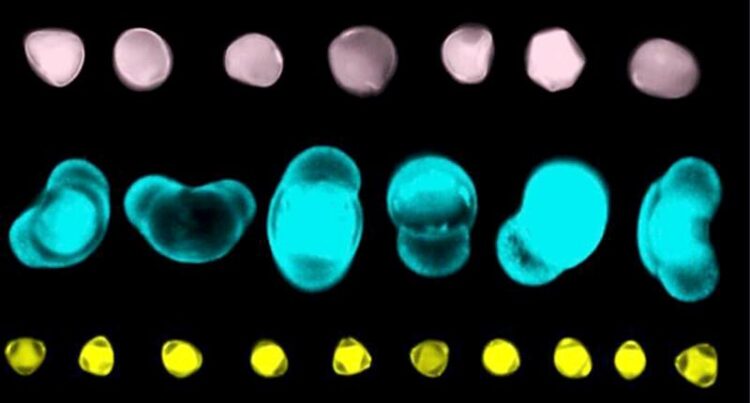Artificial intelligence could help build pollen jigsaw of present and ancient flora

Different pollen types captured via a microscope
Credit: The University of Exeter
An emerging system which combines rapid imaging with artificial intelligence could help scientists build a comprehensive picture of present and historic environmental change – by swiftly and accurately analysing pollen.
Pollen grains from different plant species are unique and identifiable based on their shape. Analysing which pollen grains are captured in samples such as sediment cores from lakes helps scientists understand which plants were thriving at any given point in history, potentially dating back thousands to millions of years.
Up to now, scientists have manually counted pollen types in sediments or from air samples using a light microscope – a specialised and time-consuming task.
Now, scientists at the University of Exeter and Swansea University are combining cutting-edge technologies including imaging flow cytometry and artificial intelligence to build a system capable of identifying and categorising pollen at much faster rates. Their progress is published today in a research paper in New Phytologist. As well as building a fuller picture of past flora, the team hope the technology could one day be applied to more accurate pollen readings in today’s environment, which may help provide hayfever sufferers to mitigate symptoms.
Dr Ann Power, of the University of Exeter, said: “Pollen is an important environmental indicator, and piecing together the jigsaw of different pollen types in the atmosphere, both today and in the past, can help us build up a picture of biodiversity and climate change.
“However, recognising what plant species pollen belongs to under a microscope is incredibly labour-intensive and cannot always be done. The system we’re developing will cut the time this takes dramatically and improve classifications. This means we can build a richer picture of pollen in the environment far more swiftly, revealing how the climate, human activity and biodiversity has changed over time, or better understand what allergens are in the air we breathe.”
The team has already used the system to automatically analyse a 5,500-year-old slice of lake sediment core, rapidly classifying over a thousand pollen grains. In the past, this would have taken a specialist up to eight hours to count and categorise – a task the new system completed in well under an hour.
The new system uses imaging flow cytometry – a technology which is typically used to investigate cells in medical research, to quickly capture pollen images. A unique type of artificial intelligence has then been developed based on deep learning to identify the different types of pollen in an environmental sample. This is able to make these distinctions even when the sample is imperfect.
Dr Claire Barnes, from Swansea University, said: “Up to now, the AI systems in development to categorise pollen learn from and test on the same pollen libraries – which means each sample is perfect and belongs to species previously seen by the network. These systems are not able to recognise pollen from the environment that’s taken some knocks along the way, nor to categorise pollen not included in training libraries. Incorporating a unique version of deep learning into our system means the artificial intelligence is smarter and applies a more flexible approach to learning. It can deal with poor quality images and can use shared species characteristics to predict what family of plant the pollen belongs to even if the system hasn’t seen it before during training.”
In the coming years, the team hopes to refine and launch the new system, and to use it to learn more about grass pollen, a particular irritant for hayfever sufferers. Dr Power said: “Some grass pollens are more allergenic than others. If we can understand better which pollens are prevalent at specific times, it would lead to improvements in the pollen forecast that could help people with hayfever plan to reduce their exposure.”
The research is supported by the National Environment Research Council (NERC) and the US National Institutes of Health. The paper is entitled ‘Deductive Automated Pollen Classification in Environmental samples via Exploratory Deep Learning and Imaging Flow Cytometry’, and is published in New Phytologist.
Media Contact
Louise Vennells
University of Exeter
pressoffice@exeter.ac.uk
Office: 0044-139-272-2062
All latest news from the category: Ecology, The Environment and Conservation
This complex theme deals primarily with interactions between organisms and the environmental factors that impact them, but to a greater extent between individual inanimate environmental factors.
innovations-report offers informative reports and articles on topics such as climate protection, landscape conservation, ecological systems, wildlife and nature parks and ecosystem efficiency and balance.
Newest articles

First-of-its-kind study uses remote sensing to monitor plastic debris in rivers and lakes
Remote sensing creates a cost-effective solution to monitoring plastic pollution. A first-of-its-kind study from researchers at the University of Minnesota Twin Cities shows how remote sensing can help monitor and…

Laser-based artificial neuron mimics nerve cell functions at lightning speed
With a processing speed a billion times faster than nature, chip-based laser neuron could help advance AI tasks such as pattern recognition and sequence prediction. Researchers have developed a laser-based…

Optimising the processing of plastic waste
Just one look in the yellow bin reveals a colourful jumble of different types of plastic. However, the purer and more uniform plastic waste is, the easier it is to…



